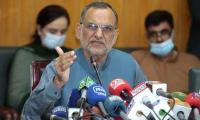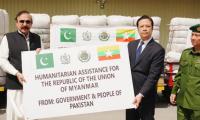ISLAMABAD: Trade deficit sharply narrowed around 27 percent year-on-year to $15.5 billion in the first eight months of the current fiscal year of 2019/20, commerce adviser said on Monday, exuding confidence over the exports sector’s upbeat outlook on upcoming tariff policy.
Adviser to the Prime Minister on Commerce Razak Dawood said the balance of trade improved by six billion dollars, compared to $21.5 billion recorded as deficit in the corresponding period a year earlier.
In July-February, exports rose 3.6 percent to $15.6 billion.
“The exports of our competitors including India, Bangladesh, Thailand and others are showing declining trends but Pakistan’s exports in both value and quantity terms are achieving growth,” Dawood said, talking to a select group of reporters.
“We are hopeful for inching close to our desired target for exports in the current fiscal year.” Commerce adviser said a new tariff policy would soon be finalised and tabled before the federal cabinet. “This tariff policy would be converted into strategic trade policy framework,” he said. However, commerce adviser underscored a need of March trade data to ascertain “whether increase in exports is a short-term phenomena or (would remain) persistent in many months to come”.
Dawood said imports fell 14.4 percent or $5.5 billion to $31 billion in the first eight months.
Official data showed that the country’s exports rose 13.6 percent year-on-year to $2.137 billion in February, which was the second month since July this year when exports achieved a double-digit growth. Monthly exports were up eight percent over January. A sudden jump in exports is seen as a possible result of clearance of consignments that were struck because of transporters’ strike last month.
Commerce adviser said exports of vegetable in value term, in the first eight months of the current fiscal, went up 71 percent, followed by meat (52 percent), basmati rice (37 percent), leather garments (13 percent), readymade garments (13 percent), fish (12 percent), footballs (12 percent), leather gloves (9 percent), knitwear (8 percent), surgical goods (7 percent) and bedwear (4 percent).
Exports of certain products declined during the period under review, such as wheat (90 percent), petroleum products (62 percent), oil seeds (58 percent), sugar (24 percent), gloves (20 percent), leather tanned (18 percent), plastic materials (9 percent), cement (6 percent), and cotton clothes (2 percent).
Dawood acknowledged that the exporters were facing refunds constraints. “But, the exporters are getting more refunds (now) compared to the last five years.” Commerce adviser said electricity tariff for export-oriented industries was restored to 7.5 cents per unit after a government’s agreement with the textile sector, “so business sentiments are improving”.
Honda officials posing for a photgraph. —APP/FileKARACHI: Honda Atlas Cars Pakistan Ltd has achieved a major...
SOS children village's children showing bags donated by Emirates International Airlines. — Emirates...
Automobiles at the shipping terminal are shown from the view of a drone in San Diego, California, US, March 26, 2025....
Key challenge lies in whether the ruling elite is willing to implement changes that could weaken their grip on power
A woman holds a smartphone displaying the logo of social network X . — AFP/FileElon Musk said his xAI artificial...
A representational image of a person using his cellphone for a digital transaction. — Unsplash/FileKARACHI: Chief...







